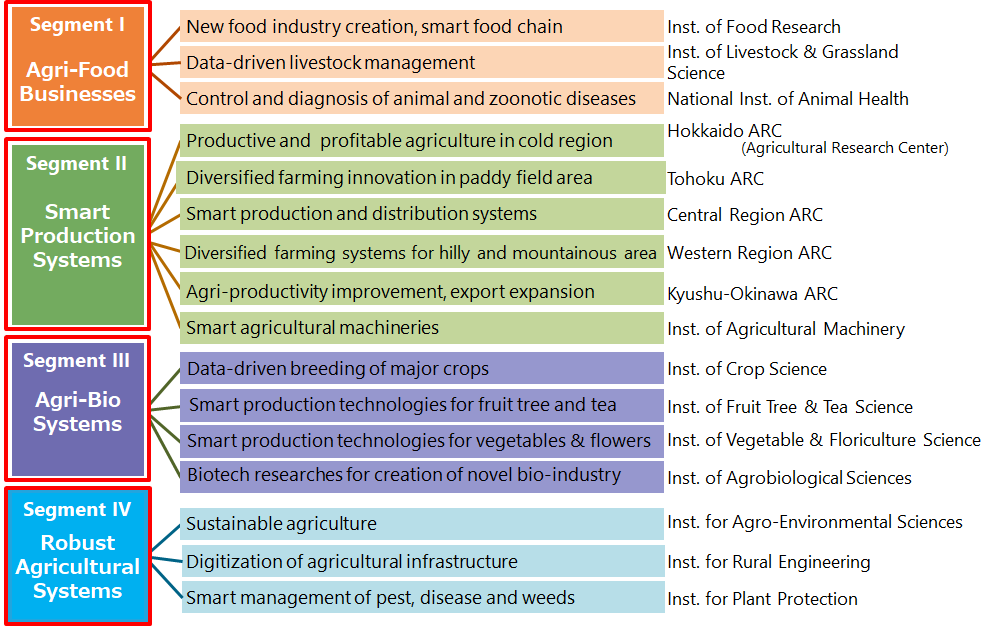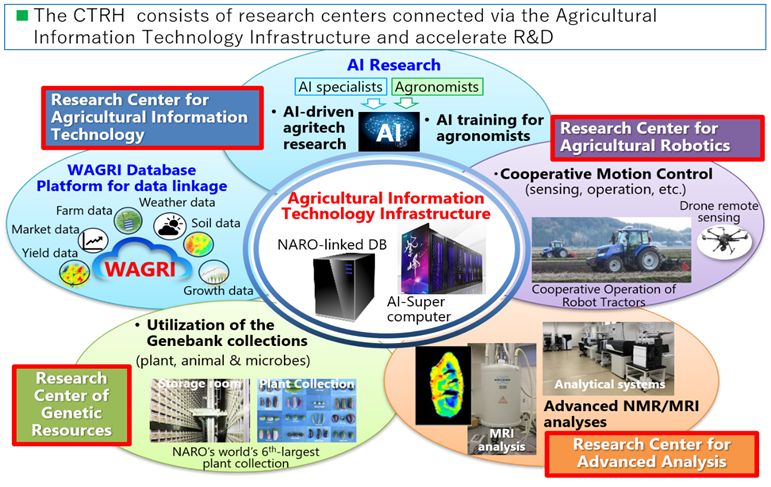Summary
NARO entered its 5th Mid-term, which is for five years from April 2021. NARO has set three organizational goals: 1) Increasing food self-sufficiency rate and ensuring food security, 2) Strengthening industrial competitiveness of agricultural products and food and expansion of exports and 3) Achieving both increased production and environment conservation. NARO is engaged in research and development (R&D) under a new organization to create innovation in the fields of agriculture and food. NARO aims to deepen and penetrate the ultra-smart society "Society 5.0" advocated by the Japanese government.
In the 5th Mid-term Plan, in order to strengthen exit-oriented R&D aimed at enhancing industrial competitiveness, NARO establishes four pillars called "segments" from the downstream of the food value chain: 1) Agri-Food Business, 2) Smart Production Systems, 3) Agri-Biosystems and 4) Robust Agricultural Systems. Under the authority and responsibility of Vice Presidents in charge of research promotion, NARO accelerates R&D activities of each institute.
NARO has set up Core Technology Research Headquarters (CTRH) directly under the president to strengthen basic technologies such as AI, robotics, and advanced analysis technology and to establish a common base for data and genetic resources. CTRH collaborates with four segments to accelerate NARO to create innovation.
In light of the active movement toward carbon neutrality, NARO strengthens research and social implementation of environmental conservation technologies in the agriculture, forestry, and fisheries fields. In addition, amid the growing global population, global warming, and the deteriorating food production environment, NARO promotes Moonshot Research and Development Program aimed at achieving both an increase in food production on a global scale and environmental conservation.
Under a clear exit strategy, NARO aims to achieve innovation which globally has a major impact both on the manufacturing and logistics industry and the society through consistently generating first-class results from research at each stage from basic to practical application.
Agriculture and food industry is a treasure trove of innovation
The value of production in the agriculture and the food industry is approximately 50 trillion JPY. The value of exports is only around 900 billion JPY and still has a high growth potential. The government targets to hit 5 trillion JPY in exports in 2030.
The agriculture and the food industry are important areas for reducing greenhouse gas (GHG) emissions, as well. GHG emissions from agriculture, livestock, and land account for 24% of the global total. Improving the productivity of agricultural products and foods while reducing GHG emissions is an important task.
The agriculture and the food industry are also frontiers of science and technology. Agriculture and food research is a research field with great potential, such as significant reduction in development time and cost, solving food shortages with genome-edited crops, regenerative medicine, organ transplantation, and AI drug discovery with medical livestock.
In order to contribute to socio-economic development through innovation by realizing these possibilities, NARO has established the following policies at the beginning of the 5th Mid-term.
Policies for the 5th Mid-term
-
Establishment of research issues to strengthen industrial competitiveness
In the 5th Mid-term, NARO set research subjects back casting from the ideal states of the agriculture and food industries, where the following three objectives should be achieved: "improving food self-sufficiency and food security," "strengthening industrial competitiveness and expanding exports," and "balancing productivity improvement with environmental conservation." To set those subjects, NARO took into account not only MAFF's Basic Plan for Food, Agriculture, and Rural Areas, but also the Cabinet Office's "Sixth Science, Technology, and Innovation Basic Plan (6th STI Basic Plan)" and MAFF's "Strategy for Sustainable Food Systems, Measures for achievement of Decarbonization and Resilience with Innovation (MeaDRI)."
NARO set four pillars of the 5th Mid-term's research subjects from the downstream of the food value chain; distribution, processing, and consumption, in order to strengthen exit-oriented R&D aimed at enhancing the industrial competitiveness. The first pillar is "Agri-Food Business," which aims to optimize distribution, processing, consumption, and the food value chain as a whole, followed by "Smart Production System," which aims to thoroughly strengthen agricultural production through smart agricultural technology, the "Agri-Bio System," which aims to create new materials and industries by integrating biotechnology and AI, and finally, the "Robust Agriculture System," which aims to build a production base resilient to climate change and disasters, and to achieve both productivity improvement and environmental conservation. (Fig. 1).
Each research institute of NARO is responsible for major research projects under these four segments. Vice Presidents in charge of research promotion of each segment are assigned to manage both organizational management and projects promotion newly by clarifying their roles, authorities and responsibilities.
NARO has positioned NARO Projects to be implemented across segments with all-out efforts. NARO Projects consist of seven research subjects include "Smart Agriculture Business," which aims to build a new business model, and "Zero Emission Agriculture," which aims to realize zero emission agriculture through livestock farming collaboration. NARO plans to proceed with NARO Projects while flexibly reviewing them in response to changes in social conditions and the acquisition of large-scale projects. -
Core Technology Research Headquarters, NARO
A Core Technology Research Headquarters, NARO (CTRH) has been established directly under President. Its objective is to accelerate the creation of innovation in collaboration with four segments by strengthening basic technologies such as AI, robotics, and advanced analytical technologies, and developing a common foundation for data, genetic resources, etc. (Fig. 2).
CTRH consists of four research centers, the core of which is Research Center for Agricultural Information Technology, NARO (RCAIT) established in October 2018. RCAIT's information research infrastructure will be thoroughly utilized, and data will be managed in an integrated manner to organically link each other. RCAIT operates the AI-based research for agriculture and "WAGRI1)" platform for collaboration on farming data.
Research Center for Agricultural Robotics, NARO develops sensing technology, high-precision growth forecasting technology, and control systems as just-in-time and quality production.
Research Center of Genetic Resources, NARO promotes the use of genetic resources in the private sector by clarifying and adding genomic information and new functions as an increasingly sophisticated means of information on genetic resources. -
Environmental conservation technologies in the agriculture, forestry and fisheries fields
NARO has already achieved researches to reduce CH4 from paddy fields and N2O from upland fields, livestock excrement and pig farming sewage purification facilities. With the trend toward carbon neutrality becoming more active, research in this field is becoming increasingly important. NARO promotes this as a major R&D subject in the agriculture, forestry, and fisheries field.
-
The Moonshot Program for agriculture, forestry, and fisheries
NARO aims to achieve both higher food production on a global scale and environmental conservation amid the growing global population, global warming, and deteriorating food production environment. As a Moonshot Program for agriculture, forestry, and fisheries aimed at disruptive innovation for the future, NARO conducts research to realize unmanned operation of farms 365 days a year, 24 hours a day, zero chemical fertilizers and pesticides and zero food waste, and to reuse surplus and waste food.
-
Aims to be a world-class research organization
NARO aims to become a world-class research organization by achieving outstanding research results at every stage from basic to practical application under a clear exit strategy, and creating innovations that have a major impact on industries and society for deepening and penetrating Society5.0 in the agricultural and food industries.
Glossary of terms
- WAGRI
- The Agricultural Data Collaboration Infrastructure WAGRI is a platform for data collaboration developed as one of the "Next-Generation Technologies for Creating Agriculture, Forestry, and Fisheries" on the Cabinet Office's Strategic Innovation Creation Program, SIP. (https://wagri.net/en-us/, confirmed to be connected in April 2021). WAGRI members can commercially use various public agricultural data of land and map information, soil, weather, market conditions, etc. and services such as crop growth and yield forecasts, etc. in addition to various paid data provided by private companies.
Reference Figures






